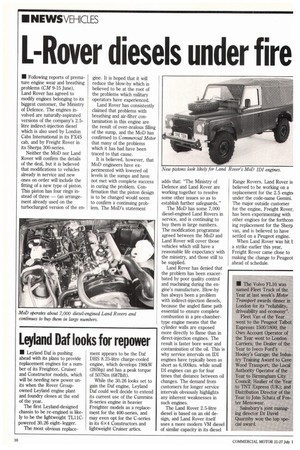1-Rover diesels under fire
Page 8

If you've noticed an error in this article please click here to report it so we can fix it.
• Following reports of premature engine wear and breathing problems (CM 9-15 June), Land Rover has agreed to modify engines belonging to its biggest customer, the Ministry of Defence. The engines involved are naturally-aspirated versions of the company's 2.5litre indirect-injection diesel which is also used by London Cabs International in its FX4S cab, and by Freight Rover in its Sherpa 300-series.
Neither the MoD nor Land Rover will confirm the details of the deal, but it is believed that modifications to vehicles already in service and new ones on order will include the fitting of a new type of piston. This piston has four rings instead of three — (an arrangement already used on the turbocharged version of the en gine. It is hoped that it will reduce the blow-by which is believed to be at the root of the problems which military operators have experienced.
Land Rover has consistently claimed that problems with breathing and air-filter contamination in this engine are the result of over-zealous filling of the sump, and the MoD has confirmed to Commercial Motor that many of the problems which it has had have been traced to that cause.
It is believed, however, that MoD engineers have experimented with lowered oil levels in the sumps and have not met with complete success in curing the problem. Confirmation that the piston design is to be changed would seem to confirm a continuing problem. The MoD's statement adds that: "The Ministry of Defence and Land Rover are working together to resolve some other issues so as to establish further safeguards."
The MoD has some 7,000 diesel-engined Land Rovers in service, and is continuing to buy them in large numbers. The modification programme agreed between the MoD and Land Rover will cover those vehicles which still have a reasonable life expectancy with the ministry, and those still to be supplied.
Land Rover has denied that the problem has been exacerbated by poor quality control and machining during the engine's manufacture. Blow-by has always been a problem with indirect-injection diesels, because the angled flame path essential to ensure complete combustion in a pre-chambertype engine means that the cylinder walls are exposed more directly to flame than in direct-injection engines. The result is faster bore wear and contamination of the oil. This is why service intervals on IDI engines have typically been as short as 6,000km. while small DI engines can go for four times that distance between oil changes. The demand from customers for longer service intervals obviously highlights any inherent weaknesses in such engines.
The Land Rover 2.5-litre diesel is based on an old design, and Land Rover itself uses a more modern \TM diesel of similar capacity in its diesel Range Rovers. Land Rover is believed to be working on a replacement for the 2.5 engin' under the code-name Gemini. The major outside customer for the engine, Freight Rover, has been experimenting with other engines for the forthcon ing replacement for the Sherp van, and is believed to have settled on a Peugeot engine.
When Land Rover was hit a strike earlier this year, Freight Rover came close to making the change to Peugeot ahead of schedule.




























































